CoCa: Contrastive Captioners are Image-Text Foundation Models
CoCa: 对比式字幕生成器作为图文基础模型
Abstract
摘要
Exploring large-scale pretrained foundation models is of significant interest in computer vision because these models can be quickly transferred to many downstream tasks. This paper presents Contrastive Captioner (CoCa), a minimalist design to pretrain an image-text encoder-decoder foundation model jointly with contrastive loss and captioning loss, thereby subsuming model capabilities from contrastive approaches like CLIP and generative methods like SimVLM. In contrast to standard encoder-decoder transformers where all decoder layers attend to encoder outputs, CoCa omits cross-attention in the first half of decoder layers to encode unimodal text representations, and cascades the remaining decoder layers which cross-attend to the image encoder for multimodal image-text representations. We apply a contrastive loss between unimodal image and text embeddings, in addition to a captioning loss on the multimodal decoder outputs which predicts text tokens auto regressive ly. By sharing the same computational graph, the two training objectives are computed efficiently with minimal overhead. CoCa is pretrained end-to-end and from scratch on both web-scale alt-text data and annotated images by treating all labels simply as text, seamlessly unifying natural language supervision for representation learning. Empirically, CoCa achieves state-of-theart performance with zero-shot transfer or minimal task-specific adaptation on a broad range of downstream tasks, spanning visual recognition (ImageNet, Kinetics400/600/700, Moments-in-Time), crossmodal retrieval (MSCOCO, Flickr30K, MSR-VTT), multimodal understanding (VQA, SNLI-VE, NLVR2), and image captioning (MSCOCO, NoCaps). Notably on ImageNet classification, CoCa obtains $86.3%$ zero-shot top-1 accuracy, $90.6%$ with a frozen encoder and learned classification head, and new state-of-the-art $91.0%$ top-1 accuracy on ImageNet with a finetuned encoder.
探索大规模预训练基础模型在计算机视觉领域具有重要意义,因为这些模型能快速迁移至多种下游任务。本文提出对比式描述生成器 (CoCa),采用极简设计联合对比损失与描述生成损失预训练图文编码器-解码器基础模型,从而兼具CLIP等对比方法与SimVLM等生成方法的模型能力。不同于所有解码层都关注编码器输出的标准编码器-解码器Transformer架构,CoCa在前半部分解码层省略跨模态注意力以编码单模态文本表征,后半部分级联的解码层则通过跨模态注意力融合图像编码器的多模态图文表征。我们在单模态图像/文本嵌入之间施加对比损失,同时在多模态解码器输出端采用自回归预测文本token的描述生成损失。通过共享计算图,这两个训练目标能以最小开销高效计算。CoCa通过将所有标注统一视为文本,实现了网络规模替代文本数据与标注图像的端到端预训练,无缝统一了表征学习的自然语言监督机制。实验表明,CoCa在视觉识别 (ImageNet、Kinetics400/600/700、Moments-in-Time)、跨模态检索 (MSCOCO、Flickr30K、MSR-VTT)、多模态理解 (VQA、SNLI-VE、NLVR2) 和图像描述生成 (MSCOCO、NoCaps) 等广泛下游任务中,通过零样本迁移或最小任务适配均取得最先进性能。特别在ImageNet分类任务中,CoCa获得86.3%的零样本Top-1准确率,冻结编码器配合可学习分类头达90.6%,微调编码器后更以91.0%的Top-1准确率刷新当前最佳纪录。
1 Introduction
1 引言
Deep learning has recently witnessed the rise of foundation language models [1] such as BERT [2], T5 [3], GPT-3 [4], where models are pretrained on web-scale data and demonstrate generic multitasking capabilities through zero-shot, few-shot or transfer learning. Compared with specialized individual models, pre training foundation models for massive downstream tasks can amortize training costs, providing opportunities to push the limits of model scale [5] for human-level intelligence.
深度学习领域近期见证了基础语言模型(foundation language models)[1]的崛起,例如BERT [2]、T5 [3]、GPT-3 [4]。这些模型通过互联网规模的数据进行预训练,并通过零样本(zero-shot)、少样本(few-shot)或迁移学习展现出通用的多任务处理能力。与专用独立模型相比,为海量下游任务预训练基础模型能够分摊训练成本,为突破模型规模极限[5]以实现人类水平智能提供了可能。
For vision and vision-language problems, several foundation model candidates have been explored: (1) Pioneering works [6, 7, 8] have shown the effectiveness of single-encoder models pretrained with cross-entropy loss on image classification datasets such as ImageNet [9]. The image encoder provides generic visual representations that can be adapted for various downstream tasks including image and video understanding [10, 11]. However, these models rely heavily on image annotations as labeled vectors and do not bake in knowledge of free-form human natural language, hindering their application to downstream tasks that involving both vision and language modalities. (2) Recently, a line of research [12, 13, 14] has shown the feasibility of image-text foundation model candidates by pre training two parallel encoders with a contrastive loss on web-scale noisy image-text pairs. In addition to the visual embeddings for vision-only tasks, the resulting dual-encoder models can additionally encode textual embeddings to the same latent space, enabling new crossmodal alignment capabilities such as zero-shot image classification and image-text retrieval. Nonetheless, these models are not directly applicable for joint vision-language understanding tasks such as visual question answering (VQA), due to missing joint components to learn fused image and text representations. (3) Another line of research [15, 16, 17] has explored generative pre training with encoder-decoder models to learn generic vision and multimodal representations. During pre training, the model takes images on the encoder side and applies Language Modeling (LM) loss (or PrefixLM [3, 16]) on the decoder outputs. For downstream tasks, the decoder outputs can then be used as joint representations for multimodal understanding tasks. While superior vision-language results [16] have been attained with pretrained encoder-decoder models, they do not produce text-only representations aligned with image embeddings, thereby being less feasible and efficient for crossmodal alignment tasks.
针对视觉与视觉-语言问题,研究者已探索了多种基础模型方案:(1) 先驱性工作[6,7,8]证明了在ImageNet[9]等图像分类数据集上采用交叉熵损失预训练的单编码器模型的有效性。这类图像编码器可提供通用视觉表征,适用于图像/视频理解[10,11]等多种下游任务。但其高度依赖标注向量形式的图像注释,未融入自由形式的人类自然语言知识,限制了其在跨视觉-语言模态任务中的应用。(2) 近期研究[12,13,14]通过在网络级噪声图文对上采用对比损失预训练双并行编码器,验证了图文基础模型的可行性。除支持纯视觉任务的视觉嵌入外,双编码器模型还能将文本嵌入编码至相同潜在空间,实现零样本图像分类和图文检索等跨模态对齐能力。但由于缺乏学习融合图文表征的联合组件,此类模型无法直接应用于视觉问答(VQA)等联合视觉-语言理解任务。(3) 另一研究方向[15,16,17]探索了采用编码器-解码器模型进行生成式预训练,以学习通用视觉及多模态表征。预训练时模型在编码端输入图像,并在解码输出端应用语言建模(LM)损失(或PrefixLM[3,16])。其解码输出可作为多模态理解任务的联合表征,虽在视觉-语言任务中取得优异效果[16],但无法生成与图像嵌入对齐的纯文本表征,导致跨模态对齐任务的可行性与效率较低。
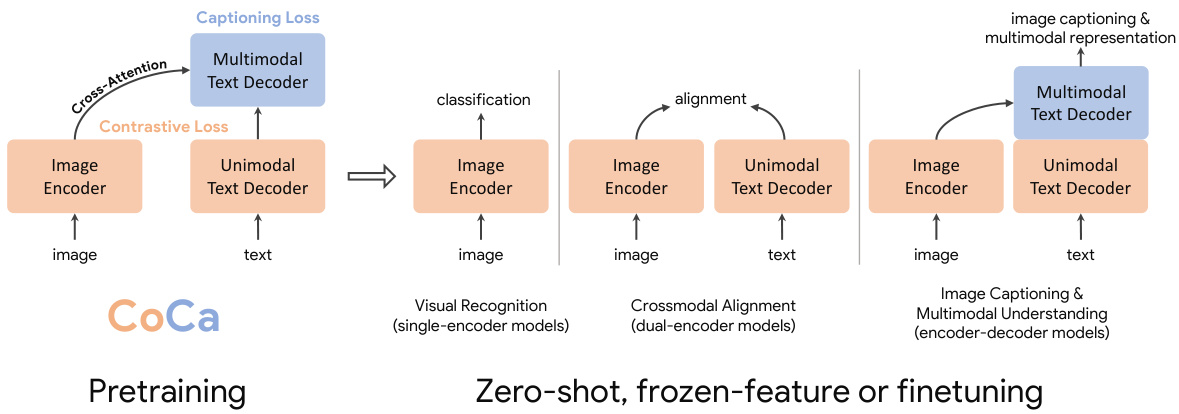
Figure 1: Overview of Contrastive Captioners (CoCa) pre training as image-text foundation models. The pretrained CoCa can be used for downstream tasks including visual recognition, vision-language alignment, image captioning and multimodal understanding with zero-shot transfer, frozen-feature evaluation or end-to-end finetuning.
图 1: 对比式字幕生成器 (CoCa) 作为图文基础模型的预训练概览。预训练后的 CoCa 可用于下游任务,包括视觉识别、视觉-语言对齐、图像描述和零样本迁移的多模态理解,支持冻结特征评估或端到端微调。
In this work, we unify single-encoder, dual-encoder and encoder-decoder paradigms, and train one image-text foundation model that subsumes the capabilities of all three approaches. We propose a simple model family named Contrastive Captioners $\mathrm{(CoCa)}$ with a modified encoder-decoder architecture trained with both contrastive loss and captioning (generative) loss. As shown in Figure 1, we decouple the decoder transformer into two parts, a unimodal decoder and a multimodal decoder. We omit cross-attention in unimodal decoder layers to encode text-only representations, and cascade multimodal decoder layers cross-attending to image encoder outputs to learn multimodal image-text representations. We apply both the contrastive objective between outputs of the image encoder and unimodal text decoder, and the captioning objective at the output of the multimodal decoder. Furthermore, CoCa is trained on both image annotation data and noisy image-text data by treating all labels simply as text. The generative loss on image annotation text provides a fine-grained training signal similar to the single-encoder cross-entropy loss approach, effectively subsuming all three pre training paradigms into a single unified method.
在本工作中,我们统一了单编码器、双编码器和编码器-解码器范式,训练了一个包含这三种方法能力的图文基础模型。我们提出了一个名为对比字幕生成器 (CoCa) 的简单模型家族,采用改进的编码器-解码器架构,同时使用对比损失和字幕生成(生成式)损失进行训练。如图 1 所示,我们将解码器 Transformer 解耦为两部分:单模态解码器和多模态解码器。我们在单模态解码器层中省略交叉注意力以编码纯文本表示,并级联多模态解码器层对图像编码器输出进行交叉注意力学习多模态图文表示。我们同时在图像编码器输出与单模态文本解码器输出之间应用对比目标,并在多模态解码器输出端应用字幕生成目标。此外,CoCa 通过将所有标签简单视为文本来同时训练图像标注数据和噪声图文数据。图像标注文本上的生成式损失提供了类似于单编码器交叉熵损失方法的细粒度训练信号,有效地将所有三种预训练范式统一为单一方法。
The design of CoCa leverages contrastive learning for learning global representations and captioning for fine-grained region-level features, thereby benefiting tasks across all three categories shown in Figure 1. CoCa shows that a single pretrained model can outperform many specialized models using zero-shot transfer or minimal task-specific adaptation. For example, CoCa obtains $86.3%$ zero-shot accuracy on ImageNet and better zero-shot crossmodal retrieval on MSCOCO and Flickr $30\mathrm{k\Omega}$ . With a frozen-encoder, CoCa achieves $90.6%$ on ImageNet classification, $88.0%/88.5%/81.1%$ on Kinetics40/600/700 and $47.4%$ on Moments-in-Time. After lightweight finetuning, CoCa further achieves $91.0%$ on ImageNet, $82.3%$ on VQA and 120.6 CIDEr score on NoCaps.
CoCa的设计利用对比学习来获取全局表征,并通过描述任务学习细粒度区域特征,从而提升图1所示三大类任务的性能。该研究表明,单一预训练模型通过零样本迁移或极少量任务适配,即可超越众多专用模型。例如,CoCa在ImageNet上实现86.3%的零样本准确率,在MSCOCO和Flickr30k上取得更优的跨模态检索效果。采用冻结编码器时,其在ImageNet分类任务达到90.6%,在Kinetics40/600/700分别获得88.0%/88.5%/81.1%,在Moments-in-Time达到47.4%。经轻量化微调后,CoCa进一步在ImageNet提升至91.0%,在VQA达到82.3%,在NoCaps获得120.6 CIDEr分数。
2 Related Work
2 相关工作
Vision Pre training. Pre training ConvNets [18] or Transformers [19] on large-scale annotated data such as ImageNet [6, 7, 8], Instagram [20] or JFT [21] has become a popular strategy towards solving visual recognition problems including classification, localization, segmentation, video recognition, tracking and many other problems. Recently, self-supervised pre training approaches have also been explored. BEiT [22] proposes a masked image modeling task following BERT [2] in natural language processing, and uses quantized visual token ids as prediction targets. MAE [23] and SimMIM [24] remove the need for an image tokenizer and directly use a light-weight decoder or projection layer to regress pixel values. Nonetheless, these methods only learn models for the vision modality and thus they are not applicable to tasks that require joint reasoning over both image and text inputs.
视觉预训练。在 ImageNet [6, 7, 8]、Instagram [20] 或 JFT [21] 等大规模标注数据上预训练 ConvNets [18] 或 Transformer [19] 已成为解决分类、定位、分割、视频识别、跟踪等视觉识别问题的流行策略。近年来,自监督预训练方法也得到探索。BEiT [22] 提出了一种遵循自然语言处理中 BERT [2] 的掩码图像建模任务,并使用量化视觉 token ID 作为预测目标。MAE [23] 和 SimMIM [24] 则无需图像分词器,直接通过轻量级解码器或投影层回归像素值。然而,这些方法仅学习视觉模态的模型,因此不适用于需要联合推理图像和文本输入的任务。
Vision-Language Pre training. In recent years, rapid progress has been made in vision-language pre training (VLP), which aims to jointly encode vision and language in a fusion model. Early work (e.g. LXMERT [25], UNITER [26], VinVL [27]) in this direction relies on pretrained object detection modules such as Fast(er) R-CNN [28] to extract visual representations. Later efforts such as ViLT [29] and VLMo [30] unify vision and language transformers, and train a multimodal transformer from scratch.
视觉语言预训练。近年来,视觉语言预训练(VLP)取得了快速进展,其目标是在融合模型中联合编码视觉和语言信息。该领域的早期工作(如 LXMERT [25]、UNITER [26]、VinVL [27])依赖于预训练的目标检测模块(如 Fast(er) R-CNN [28])来提取视觉表征。后续研究如 ViLT [29] 和 VLMo [30] 则统一了视觉与语言的 Transformer,并从头开始训练多模态 Transformer。
Image-Text Foundation Models. Recent work has proposed image-text foundation models that can subsume both vision and vision-language pre training. CLIP [12] and ALIGN [13] demonstrate that dual-encoder models pretrained with contrastive objectives on noisy image-text pairs can learn strong image and text representations for crossmodal alignment tasks and zero-shot image classification. Florence [14] further develops this method with unified contrastive objective [31], training foundation models that can be adapted for a wide range of vision and image-text benchmarks. To further improve zero-shot image classification accuracy, LiT [32] and BASIC [33] first pretrain model on an largescale image annotation dataset with cross-entropy and further finetune with contrastive loss on an noisy alt-text image dataset. Another line of research [16, 17, 34] proposes encoder-decoder models trained with generative losses and shows strong results in vision-language benchmarks while the visual encoder still performs competitively on image classification. In this work, we focus on training an image-text foundation model from scratch in a single pre training stage to unify these approaches. While recent works [35, 36, 37] have also explored image-text unification, they require multiple pre training stages of unimodal and multimodal modules to attain good performance. For example, ALBEF [36] combines contrastive loss with masked language modelling (MLM) with a dual-encoder design. However, our approach is simpler and more efficient to train while also enables more model capabilities: (1) CoCa only performs one forward and backward propagation for a batch of image-text pairs while ALBEF requires two (one on corrupted inputs and another without corruption), (2) CoCa is trained from scratch on the two objectives only while ALBEF is initialized from pretrained visual and textual encoders with additional training signals including momentum modules. (3) The decoder architecture with generative loss is preferred for natural language generation and thus directly enables image captioning and zero-shot learning [16].
图文基础模型。近期研究提出了能同时涵盖视觉与视觉语言预训练的图文基础模型。CLIP [12]和ALIGN [13]证明,通过在噪声图文对上采用对比目标预训练的双编码器模型,可学习到适用于跨模态对齐任务和零样本图像分类的强大表征。Florence [14]通过统一对比目标[31]进一步发展该方法,训练出可适配多种视觉与图文基准的基础模型。为提升零样本图像分类准确率,LiT [32]与BASIC [33]先在大型图像标注数据集上用交叉熵预训练模型,再基于噪声替代文本图像数据集进行对比损失微调。另一研究方向[16,17,34]提出采用生成式损失的编码器-解码器模型,在视觉语言基准中表现优异,同时视觉编码器在图像分类任务中仍具竞争力。本研究聚焦于通过单一预训练阶段从头训练图文基础模型以统一这些方法。尽管近期工作[35,36,37]也探索了图文统一,但它们需要多阶段预训练单模态与多模态模块以获得良好性能。例如ALBEF [36]在双编码器设计中结合对比损失与掩码语言建模(MLM)。而我们的方法训练更简单高效且具备更多能力:(1) CoCa对每批图文仅需一次前向-反向传播,而ALBEF需两次(含损坏输入与未损坏输入各一次);(2) CoCa仅基于两个目标从头训练,而ALBEF需从预训练的视觉文本编码器初始化并附加动量模块等训练信号;(3) 采用生成式损失的解码器架构更适用于自然语言生成,因此可直接支持图像描述与零样本学习[16]。
3 Approach
3 方法
We begin with a review of three foundation model families that utilize natural language supervision differently: single-encoder classification pre training, dual-encoder contrastive learning, and encoderdecoder image captioning. We then introduce Contrastive Captioners (CoCa) that share the merits of both contrastive learning and image-to-caption generation under a simple architecture. We further discuss how CoCa models can quickly transfer to downstream tasks with zero-shot transfer or minimal task adaptation.
我们首先回顾三种采用不同自然语言监督方式的基座模型家族:单编码器分类预训练、双编码器对比学习和编码器-解码器图像描述生成。随后介绍对比式描述生成器 (CoCa) ,该模型在简洁架构下同时具备对比学习和图像到文本生成的双重优势。进一步探讨CoCa模型如何通过零样本迁移或极少量任务适配快速迁移至下游任务。
3.1 Natural Language Supervision
3.1 自然语言监督
Single-Encoder Classification. The classic single-encoder approach pretrains a visual encoder through image classification on a large crowd-sourced image annotation dataset (e.g., ImageNet [9], Instagram [20] or JFT [21]), where the vocabulary of annotation texts is usually fixed. These image annotations are usually mapped into discrete class vectors to learn with a cross-entropy loss as
单编码器分类。经典的单编码器方法通过在大型众包图像标注数据集(如ImageNet [9]、Instagram [20]或JFT [21])上进行图像分类来预训练视觉编码器,其中标注文本的词汇通常是固定的。这些图像标注通常被映射为离散的类别向量,通过交叉熵损失进行学习。
$$
\begin{array}{r}{\mathcal{L}{\mathrm{Cls}}=-p(y)\log q_{\theta}(x),}\end{array}
$$
$$
\begin{array}{r}{\mathcal{L}{\mathrm{Cls}}=-p(y)\log q_{\theta}(x),}\end{array}
$$
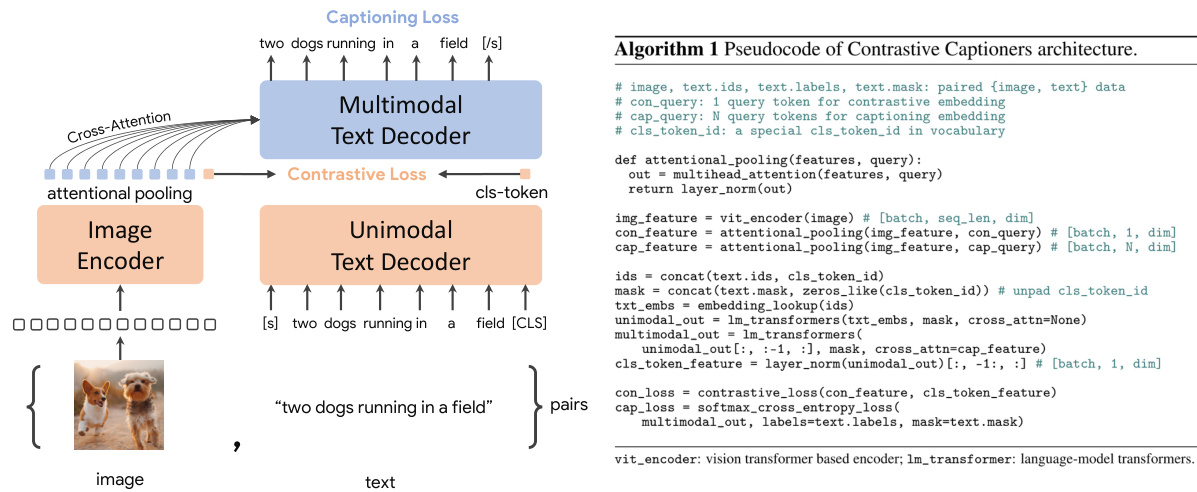
Figure 2: Detailed illustration of CoCa architecture and training objectives.
图 2: CoCa架构及训练目标的详细说明。
where $p(y)$ is a one-hot, multi-hot or smoothed label distribution from ground truth label $y$ . The learned image encoder is then used as a generic visual representation extractor for downstream tasks.
其中 $p(y)$ 是来自真实标签 $y$ 的独热 (one-hot) 、多热 (multi-hot) 或平滑标签分布。学习到的图像编码器随后被用作下游任务的通用视觉表示提取器。
Dual-Encoder Contrastive Learning. Compared to pre training with single-encoder classification, which requires human-annotated labels and data cleaning, the dual-encoder approach exploits noisy web-scale text descriptions and introduces a learnable text tower to encode free-form texts. The two encoders are jointly optimized by contrasting the paired text against others in the sampled batch:
双编码器对比学习。与需要人工标注标签和数据清洗的单编码器分类预训练相比,双编码器方法利用嘈杂的网络规模文本描述,并引入可学习的文本塔(text tower)来编码自由格式文本。两个编码器通过将配对文本与采样批次中的其他文本进行对比来联合优化:
$$
\mathcal{L}{\mathrm{Con}}=-\frac{1}{N}(\sum_{i}^{N}\log\frac{\exp(x_{i}^{\top}y_{i}/\sigma)}{\sum_{j=1}^{N}\exp(x_{i}^{\top}y_{j}/\sigma)}+\sum_{i}^{N}\log\frac{\exp(y_{i}^{\top}x_{i}/\sigma)}{\sum_{j=1}^{N}\exp(y_{i}^{\top}x_{j}/\sigma)}),
$$
$$
\mathcal{L}{\mathrm{Con}}=-\frac{1}{N}(\sum_{i}^{N}\log\frac{\exp(x_{i}^{\top}y_{i}/\sigma)}{\sum_{j=1}^{N}\exp(x_{i}^{\top}y_{j}/\sigma)}+\sum_{i}^{N}\log\frac{\exp(y_{i}^{\top}x_{i}/\sigma)}{\sum_{j=1}^{N}\exp(y_{i}^{\top}x_{j}/\sigma)}),
$$
where $x_{i}$ and $y_{j}$ are normalized embeddings of the image in the $i$ -th pair and that of the text in the $j$ -th pair. $N$ is the batch size, and $\sigma$ is the temperature to scale the logits. In addition to the image encoder, the dual-encoder approach also learns an aligned text encoder that enables crossmodal alignment applications such as image-text retrieval and zero-shot image classification. Empirical evidence shows zero-shot classification is more robust [12, 13, 38] on corrupted or out-of-distribution images.
其中 $x_{i}$ 和 $y_{j}$ 分别是第 $i$ 对图像和第 $j$ 对文本的归一化嵌入向量。$N$ 为批次大小,$\sigma$ 是用于缩放逻辑值的温度参数。除图像编码器外,双编码器方法还学习一个对齐的文本编码器,可实现跨模态对齐应用(如图文检索和零样本图像分类)。实证研究表明,零样本分类在损坏或分布外图像上更具鲁棒性 [12, 13, 38]。
Encoder-Decoder Captioning. While the dual-encoder approach encodes the text as a whole, the generative approach (a.k.a. captioner) aims for detailed granularity and requires the model to predict the exact tokenized texts of $y$ auto regressive ly. Following a standard encoder-decoder architecture, the image encoder provides latent encoded features (e.g., using a Vision Transformer [39] or ConvNets [40]) and the text decoder learns to maximize the conditional likelihood of the paired text $y$ under the forward auto regressive factorization:
编码器-解码器字幕生成。双编码器方法将文本整体编码,而生成式方法(又称字幕生成器)追求细粒度,要求模型以自回归方式预测 $y$ 的精确分词文本。遵循标准编码器-解码器架构,图像编码器提供潜在编码特征(例如使用 Vision Transformer [39] 或 ConvNets [40]),文本解码器则通过前向自回归分解学习最大化配对文本 $y$ 的条件似然:
$$
\mathcal{L}{\mathrm{Cap}}=-\sum_{t=1}^{T}\log P_{\theta}(y_{t}|y_{<t},x).
$$
$$
\mathcal{L}{\mathrm{Cap}}=-\sum_{t=1}^{T}\log P_{\theta}(y_{t}|y_{<t},x).
$$
The encoder-decoder is trained with teacher-forcing [41] to parallel ize computation and maximize learning efficiency. Unlike prior methods, the captioner approach yields a joint image-text representation that can be used for vision-language understanding, and is also capable of image captioning applications with natural language generation.
编码器-解码器采用教师强制 (teacher-forcing) [41] 进行训练,以实现并行计算并最大化学习效率。与先前方法不同,该描述生成器能产生可用于视觉-语言理解的联合图像-文本表征,同时具备通过自然语言生成实现图像描述应用的能力。
3.2 Contrastive Captioners Pre training
3.2 对比式字幕生成预训练
Figure 2 depicts the proposed contrastive captioner (CoCa): a simple encoder-decoder approach that seamlessly combines the three training paradigms. Similar to standard image-text encoderdecoder models, CoCa encodes images to latent representations by a neural network encoder, for example, vision transformer (ViT) [39] (used by default; it can also be other image encoders like ConvNets [40]), and decodes texts with a causal masking transformer decoder. Unlike standard decoder transformers, CoCa omits cross-attention in the first half of the decoder layers to encode unimodal text representations, and cascades the rest of the decoder layers, cross-attending to the image encoder for multimodal image-text representations. As a result, the CoCa decoder simultaneously produces both unimodal and multimodal text representations that allow us to apply both contrastive and generative objectives as
图 2: 展示了提出的对比式字幕生成器 (CoCa) —— 一种无缝整合三种训练范式的简单编码器-解码器方案。与标准图文编码器-解码器模型类似,CoCa 通过神经网络编码器 (默认采用视觉 Transformer (ViT) [39],也可选用 ConvNets [40] 等其他图像编码器) 将图像编码为潜在表征,并通过因果掩码 Transformer 解码器生成文本。不同于标准解码器 Transformer,CoCa 在前半部分解码层省略交叉注意力机制以编码单模态文本表征,后半部分解码层则级联图像编码器实现跨模态图文表征。因此,CoCa 解码器能同步生成单模态与多模态文本表征,从而支持对比式与生成式目标函数的联合优化。
Table 1: Size variants of CoCa. Both image encoder and text decoder are Transformers [19, 39].
| 图像编码器 (Image Encoder) | 文本解码器 (Text Decoder) | 图像/文本 | ||||||||
|---|---|---|---|---|---|---|---|---|---|---|
| 模型 | 层数 (Layers) | MLP | 参数量 (Params) | 单头 (Muni) | 多头 (Nmulti) | MLP | 参数量 (Params) | 隐藏层 (Hidden) | 头数 (Heads) | 总参数量 (TotalParams) |
| CoCa-Base | 12 | 3072 | 86M | 12 | 12 | 3072 | 297M | 768 | 12 | 383M |
| CoCa-Large | 24 | 4096 | 303M | 12 | 12 | 4096 | 484M | 1024 | 16 | 787M |
| CoCa | 40 | 6144 | 1B | 18 | 18 | 5632 | 1.1B | 1408 | 16 | 2.1B |
表 1: CoCa的尺寸变体。图像编码器和文本解码器均为Transformer [19, 39]。
$$
\mathcal{L}{\mathrm{CoCa}}=\lambda_{\mathrm{Con}}\cdot\mathcal{L}{\mathrm{Con}}+\lambda_{\mathrm{Cap}}\cdot\mathcal{L}_{\mathrm{Cap}},
$$
$$
\mathcal{L}{\mathrm{CoCa}}=\lambda_{\mathrm{Con}}\cdot\mathcal{L}{\mathrm{Con}}+\lambda_{\mathrm{Cap}}\cdot\mathcal{L}_{\mathrm{Cap}},
$$
where $\lambda_{\mathrm{Con}}$ and $\lambda_{\mathrm{Cap}}$ are loss weighting hyper-parameters. We note that the single-encoder crossentropy classification objective can be interpreted as a special case of the generative approach applied on image annotation data, when the vocabulary is the set of all label names.
其中$\lambda_{\mathrm{Con}}$和$\lambda_{\mathrm{Cap}}$是损失加权超参数。我们注意到,当词汇表是所有标签名称的集合时,单编码器交叉熵分类目标可以解释为应用于图像标注数据的生成式方法的一个特例。
Decoupled Text Decoder and CoCa Architecture. The captioning approach optimizes the conditional likelihood of text while the contrastive approach uses an unconditional text representation. To address this dilemma and combine these two methods into a single model, we propose a simple decoupled decoder design where we split the decoder into unimodal and multimodal components, by skipping the cross-attention mechanism in the unimodal decoder layers. That is, the bottom $n_{\mathrm{uni}}$ unimodal decoder layers encode the input text as latent vectors with causally-masked self-attention, and the top $n_{\mathrm{multi}}$ multimodal layers further apply causally-masked self-attention and together with cross-attention to the output of the visual encoder. All decoder layers prohibit tokens from attending to future tokens, and it is straightforward to use the multimodal text decoder output for the captioning objective ${\mathcal{L}}{\mathrm{Cap}}$ . For the contrastive objective $\mathcal{L}{\mathrm{Con}}$ , we append a learnable [CLS] token at the end of the input sentence and use its corresponding output of unimodal decoder as the text embedding. We split the decoder in half such that $n_{\mathrm{uni}}=n_{\mathrm{multi}}$ . Following ALIGN [13], we pretrain with image resolution of $288\times288$ and patch size $18\times18$ , resulting in a total of 256 image tokens. Our largest CoCa model ("CoCa" in short) follows the ViT-giant setup in [21] with 1B-parameters in the image encoder and 2.1B-parameters altogether with the text decoder. We also explore two smaller variants of “CoCa-Base” and “CoCa-Large” detailed in Table 1.
解耦文本解码器与CoCa架构。字幕生成方法优化文本的条件似然,而对比方法采用无条件文本表示。为解决这一矛盾并将两种方法整合到单一模型中,我们提出简单的解耦解码器设计:通过跳过单模态解码器层的交叉注意力机制,将解码器拆分为单模态和多模态组件。具体而言,底部的$n_{\mathrm{uni}}$层单模态解码器通过因果掩码自注意力将输入文本编码为潜在向量,顶部的$n_{\mathrm{multi}}$层多模态解码器则进一步施加因果掩码自注意力,并与视觉编码器输出进行交叉注意力交互。所有解码器层均禁止token关注未来token,可直接将多模态文本解码器输出用于字幕目标${\mathcal{L}}{\mathrm{Cap}}$。对于对比目标$\mathcal{L}{\mathrm{Con}}$,我们在输入句末添加可学习的[CLS]token,并使用其对应的单模态解码器输出作为文本嵌入。我们将解码器均等拆分使$n_{\mathrm{uni}}=n_{\mathrm{multi}}$。遵循ALIGN[13],采用$288\times288$图像分辨率和$18\times18$分块尺寸进行预训练,共生成256个图像token。最大规模的CoCa模型(简称"CoCa")采用[21]中的ViT-giant配置,图像编码器参数量达10亿,结合文本解码器总参数量21亿。表1还详述了我们探索的两种小型变体"CoCa-Base"和"CoCa-Large"。
Attention al Poolers. It is noteworthy that the contrastive loss uses a single embedding for each image while the decoder usually attends to a sequence of image output tokens in an encoder-decoder captioner [16]. Our preliminary experiments show that a single pooled image embedding helps visual recognition tasks as a global representation, while more visual tokens (thus more fine-grained) are beneficial for multimodal understanding tasks which require region-level features. Hence, CoCa adopts task-specific attention al pooling [42] to customize visual representations to be used for different types of training objectives and downstream tasks. Here, a pooler is a single multi-head attention layer with $n_{\mathrm{query}}$ learnable queries, with the encoder output as both keys and values. Through this, the model can learn to pool embeddings with different lengths for the two training objectives, as shown in Figure 2. The use of task-specific pooling not only addresses different needs for different tasks but also introduces the pooler as a natural task adapter. We use attention al poolers in pre training for generative loss $n_{\mathrm{query}}=256$ and contrastive loss $n_{\mathrm{query}}=1$ .
注意力池化器 (attention al poolers)。值得注意的是,对比损失使用单个嵌入表示每张图像,而解码器通常在编码器-解码器结构的字幕生成器 [16] 中关注一系列图像输出 token。我们的初步实验表明,单个池化后的图像嵌入作为全局表征有助于视觉识别任务,而更多视觉 token(即更细粒度)则对需要区域级特征的多模态理解任务更有利。因此,CoCa 采用任务特定的注意力池化 [42] 来定制适用于不同类型训练目标和下游任务的视觉表征。这里的池化器是一个包含 $n_{\mathrm{query}}$ 个可学习查询的单层多头注意力机制,以编码器输出同时作为键和值。通过这种方式,模型可以学习为两种训练目标生成不同长度的池化嵌入,如图 2 所示。任务特定池化的使用不仅满足了不同任务的差异化需求,还将池化器自然地转化为任务适配器。在预训练中,我们为生成式损失 ($n_{\mathrm{query}}=256$) 和对比损失 ($n_{\mathrm{query}}=1$) 分别配置了注意力池化器。
Pre training Efficiency. A key benefit of the decoupled auto regressive decoder design is that it can compute two training losses considered efficiently. Since unidirectional language models are trained with causal masking on complete sentences, the decoder can efficiently generate outputs for both contrastive and generative losses with a single forward propagation (compared to two passes for a bidirectional approach [36]). Therefore, the majority of the compute is shared between the two losses and CoCa only induces minimal overhead compared to standard encoder-decoder models. On the other hand, while many existing methods [30, 32, 33, 35, 36, 37] train model components with multiple stages on various data sources and/or modalities, CoCa is pretrained end-to-end from scratch directly with various data sources (i.e., annotated images and noisy alt-text images) by treating all labels as texts for both contrastive and generative objectives.
预训练效率。解耦自回归解码器设计的一个关键优势在于能够高效计算两种训练损失。由于单向语言模型采用因果掩码在完整句子上进行训练,解码器仅需单次前向传播即可同时生成对比损失和生成损失的输出(而双向方法需要两次前向传播[36])。因此两种损失共享了大部分计算量,相比标准编码器-解码器模型,CoCa仅引入极小开销。另一方面,现有方法[30, 32, 33, 35, 36, 37]通常需要分多阶段在不同数据源和/或模态上训练模型组件,而CoCa通过将所有标签视为文本(服务于对比和生成双重目标),直接利用多样化数据源(即标注图像和含噪声替代文本图像)进行端到端的从头预训练。
3.3 Contrastive Captioners for Downstream Tasks
3.3 面向下游任务的对比式字幕生成器
Zero-shot Transfer. A pretrained CoCa model performs many tasks in a zero-shot manner by leveraging both image and text inputs, including zero-shot image classification, zero-shot image-text cross-retrieval, zero-shot video-text cross-retrieval. Following previous practices [12, 32], “zero-shot” here is different from classical zero-shot learning in that during pre training, the model may see relevant supervised information, but no supervised examples are used during the transfer protocol. For the pre training data, we follow strict de-duplication procedures introduced in [13, 32] to filter all near-domain examples to our downstream tasks.
零样本迁移。预训练的CoCa模型通过同时利用图像和文本输入,能以零样本方式执行多种任务,包括零样本图像分类、零样本图文交叉检索、零样本视频文本交叉检索。遵循先前实践[12, 32],此处的"零样本"不同于经典零样本学习,因为在预训练阶段模型可能接触过相关监督信息,但在迁移协议中未使用任何监督样本。对于预训练数据,我们采用[13, 32]提出的严格去重流程,过滤所有与下游任务相关的近域样本。
Frozen-feature Evaluation. As discussed in the previous section, CoCa adopts task-specific attentional pooling [42] (pooler for brevity) to customize visual representations for different types downstream tasks while sharing the backbone encoder. This enables the model to obtain strong performance as a frozen encoder where we only learn a new pooler to aggregate features. It can also benefit to multi-task problems that share the same frozen image encoder computation but different task-specific heads. As also discussed in [23], linear-evaluation struggles to accurately measure learned representations and we find the attention al poolers are more practical for real-world applications.
冻结特征评估。如前一节所述,CoCa采用任务特定的注意力池化[42](简称pooler)来为不同类型的下游任务定制视觉表示,同时共享骨干编码器。这使得模型作为冻结编码器时能够获得强大的性能,我们只需学习一个新的pooler来聚合特征。这种方法同样适用于多任务问题,这些问题共享相同的冻结图像编码器计算,但使用不同的任务特定头部。如[23]中所讨论的,线性评估难以准确衡量学习到的表示,我们发现注意力池化在实际应用中更为实用。
CoCa for Video Action Recognition. We use a simple approach to enable a learned CoCa model for video action recognition tasks. We first take multiple frames of a video and feed each frame into the shared image encoder individually as shown in Figure 3. For frozenfeature evaluation or finetuning, we learn an additional pooler on top of the spatial and temporal feature tokens with a softmax cross-entropy loss. Note the pooler has a single query token thus the computation of pooling over all spatial and temporal tokens is not expensive. For zero-shot video-text retrieval, we use an even simpler approach by computing the mean embedding of 16 frames of the video (frames are uniformly sampled from a video). We also encode the captions of each video as target embeddings when computing retrieval metrics.
用于视频动作识别的CoCa。我们采用一种简单方法,使训练好的CoCa模型能够处理视频动作识别任务。如图3所示,首先提取视频的多帧画面,将每帧分别输入共享图像编码器。在冻结特征评估或微调阶段,我们会在空间和时间特征token之上学习一个额外的池化器(pooler),采用softmax交叉熵损失函数。请注意该池化器仅使用单个查询token,因此对所有时空token进行池化计算的开销并不大。对于零样本视频-文本检索任务,我们采用更简单的方法:计算视频16帧的嵌入均值(帧是从视频中均匀采样的)。在计算检索指标时,我们还会将每个视频的字幕编码为目标嵌入向量。
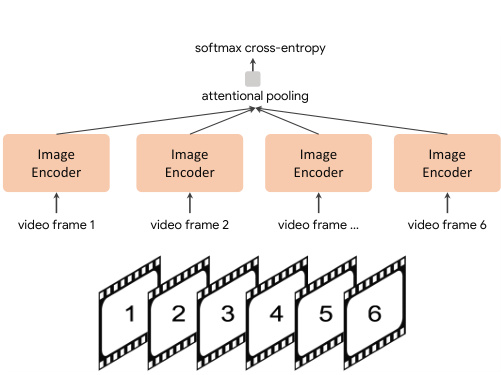
Figure 3: CoCa for video recognition.
图 3: 用于视频识别的 CoCa。
4 Experiments
4 实验
In this section, we first describe the details of our experimental setup. The main results are presented next organized as visual recognition tasks, crossmodal alignment tasks, image captioning and multimodal understanding tasks. Our main results are conducted under three categories for downstream tasks: zero-shot transfer, frozen-feature evaluation and finetuning. We also present ablation experiments including training objectives and architecture designs.
在本节中,我们首先介绍实验设置的细节。随后按视觉识别任务、跨模态对齐任务、图像描述及多模态理解任务的分类呈现主要结果。下游任务实验主要分为三类:零样本迁移、冻结特征评估和微调。我们还开展了包括训练目标和架构设计在内的消融实验。
4.1 Training Setup
4.1 训练设置
Data. As discussed in Section 3.2, CoCa is pretrained from scratch in a single stage on both webscale alt-text data and annotated images by treating all labels simply as texts. We use the JFT-3B dataset [21] with label names as the paired texts, and the ALIGN dataset [13] with noisy alt-texts. Similar to [33], we randomly shuffle and concatenate label names of each image in JFT together with a prompt sampled from [12]. An example of the resulting text label of a JFT image would look like “a photo of the cat, animal”. Unlike prior models [32, 33] that also use the combination of these two datasets, we train all model parameters from scratch at the same time without pre training an image encoder with supervised cross-entropy loss for simplicity and pre training efficiency. To ensure fair evaluation, we follow the strict de-duplication procedures introduced in [13, 32] to filter all near-domain examples (3.6M images are removed in total) to our downstream tasks. To tokenize text input, we use a sentence-piece model [43, 44] with a vocabulary size of 64k trained on the sampled pre training dataset.
数据。如第3.2节所述,CoCa通过将所有标签简单视为文本,在单阶段中同时从网络规模替代文本数据和标注图像进行预训练。我们使用JFT-3B数据集[21](以标签名称作为配对文本)和ALIGN数据集[13](含噪声替代文本)。类似[33]的做法,我们将JFT中每张图像的标签名称随机打乱后,与从[12]采样的提示词拼接。例如JFT图像的生成文本标签可能呈现为"一张猫的照片,动物"。与同样使用这两个数据集组合的先前模型[32, 33]不同,为简化流程并提升预训练效率,我们同时从头训练所有模型参数,而非先用监督交叉熵损失预训练图像编码器。为确保公平评估,我们遵循[13, 32]提出的严格去重流程,过滤所有近域样本(共移除360万张图像)以用于下游任务。文本输入的分词处理采用基于采样预训练数据集训练的64k词表大小的sentence-piece模型[43, 44]。
Optimization. Our models are implemented in the Lingvo framework [45] with GSPMD [46, 47, 48, 49] for scaling performance. Following [33], we use a batch size of 65,536 image-text pairs, where half of each batch comes from JFT and ALIGN, respectively. All models are trained on the combined contrastive and captioning objectives in Eq.(4) for $500\mathrm{k}$ steps, roughly corresponding to 5 epochs on JFT and 10 epochs on ALIGN. As shown later in our studies, we find a larger captioning loss weight is better and thus $\lambda_{\mathrm{Cap}}=2.0$ and $\lambda_{\mathrm{Con}}=1.0$ . Following [13], we apply a contrastive loss with a trainable temperature $\tau$ with an initial value of 0.07. For memory efficiency, we use the Adafactor [50] optimizer with $\beta_{1}=0.9$ , $\beta_{2}=0.999$ and decoupled weight decay ratio of 0.01. We warm up the learning rate for the first $2%$ of training steps to a peak value of $8\times\mathrm{10^{-4}}$ , and linearly decay it afterwards. Pre training $\mathrm{{CoCa}}$ takes about 5 days on 2,048 CloudTPUv4 chips. Following [12, 13, 14], we continue pre training for one epoch on a higher resolution of $576\times576$ . For finetuning evaluation, we mainly follow simple protocols and directly train CoCa on downstream tasks without further metric-specific tuning like CIDEr scores (details in Appendix A and B).
优化。我们的模型基于Lingvo框架[45]实现,并采用GSPMD[46, 47, 48, 49]进行性能扩展。参照[33],我们使用65,536个图文对作为批次大小,其中每批数据各半分别来自JFT和ALIGN数据集。所有模型均采用公式(4)中的对比学习与描述生成联合目标进行训练,共进行$500\mathrm{k}$步迭代,约相当于JFT数据集的5个周期和ALIGN数据集的10个周期。后续研究表明,增大描述生成损失权重效果更佳,因此设定$\lambda_{\mathrm{Cap}}=2.0$和$\lambda_{\mathrm{Con}}=1.0$。参照[13],我们采用可训练温度参数$\tau$的对比损失函数,初始值设为0.07。为提升内存效率,使用Adafactor[50]优化器,参数设置为$\beta_{1}=0.9$、$\beta_{2}=0.999$,解耦权重衰减率为0.01。在前$2%$训练步数中线性预热学习率至峰值$8\times\mathrm{10^{-4}}$,之后线性衰减。在2,048块CloudTPUv4芯片上预训练$\mathrm{{CoCa}}$约需5天。遵循[12, 13, 14]的方法,我们继续以$576\times576$更高分辨率进行一个周期的预训练。微调评估阶段主要采用简单协议,直接在下游任务上训练CoCa模型,未针对CIDEr等指标进行额外调优(详见附录A和B)。
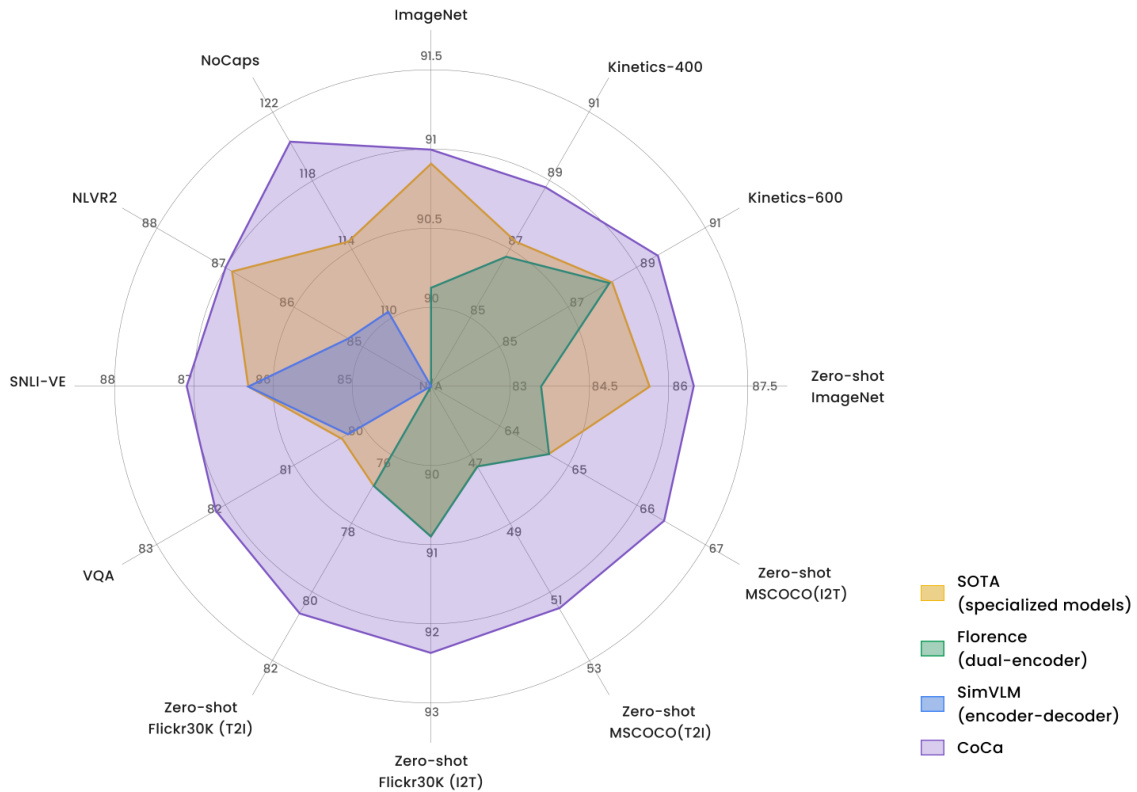

Figure 4: Comparison of CoCa with other image-text foundation models (without task-specific customization) and multiple state-of-the-art task-specialized models.
Table 2: Image classification and video action recognition with frozen encoder or finetuned encoder.
图 4: CoCa与其他图文基础模型(未进行任务定制)及多个顶尖任务专用模型的对比。
| 模型 | ImageNet | 模型 | K-400 | K-600 | K-700 | Moments-in-Time |
|---|---|---|---|---|---|---|
| ALIGN[13] | 88.6 | ViViT [53] | 84.8 | 84.3 | 38.0 | |
| Florence [14] | 90.1 | MoViNet [54] | 81.5 | 84.8 | 79.4 | 40.2 |
| MetaPseudoLabels[51] | 90.2 | VATT [55] | 82.1 | 83.6 | 41.1 | |
| CoAtNet[10] | 90.9 | Florence[14] | 86.8 | 88.0 | ||
| ViT-G[21] | 90.5 | MaskFeat [56] | 87.0 | 88.3 | 80.4 | |
| + Model Soups [52] | 90.9 | CoVeR [11] | 87.2 | 87.9 | 78.5 | 46.1 |
| CoCa (frozen) | 90.6 | CoCa (frozen) | 88.0 | 88.5 | 81.1 | 47.4 |
| CoCa(finetuned) | 91.0 | CoCa(finetuned) | 88.9 | 89.4 | 82.7 | 49.0 |
表 2: 使用冻结编码器或微调编码器进行图像分类和视频动作识别的结果。
4.2 Main Results
4.2 主要结果
We extensively evaluate the capabilities of CoCa models on a wide range of downstream tasks as a pretrained foundation model. We mainly consider core tasks of three categories that examine (1)
我们广泛评估了CoCa模型作为预训练基础模型在各类下游任务上的能力。主要考察三大类核心任务:(1)
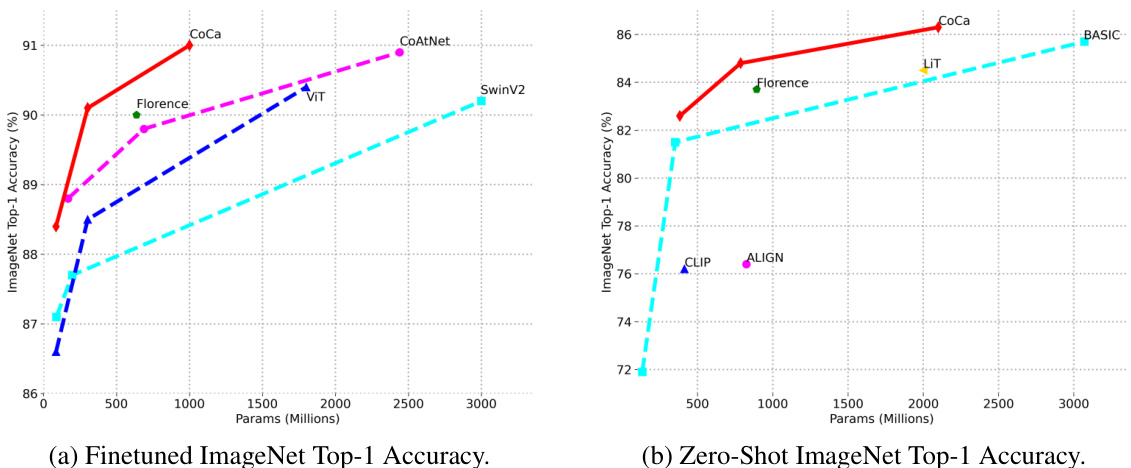
Figure 5: Image classification scaling performance of model sizes.
图 5: 不同模型尺寸的图像分类扩展性能。
visual recognition, (2) crossmodal alignment, and (3) image captioning and multimodal understanding capabilities. Since CoCa produces both aligned unimodal representations and fused multimodal embeddings at the same time, it is easily transferable to all three task groups with minimal adaption. Figure 4 summarizes the performance on key benchmarks of CoCa compared to other dual-encoder and encoder-decoder foundation models and state-of-the-art task-specialized methods. CoCa sets new state-of-the-art results on tasks of all three categories with a single pretrained checkpoint.
视觉识别、(2) 跨模态对齐、(3) 图像描述与多模态理解能力。由于CoCa能同时生成对齐的单模态表征和融合的多模态嵌入,只需极少量适配即可迁移到上述三类任务。图4对比了CoCa与其他双编码器-解码器基础模型及专项最优方法在核心基准测试中的表现。CoCa仅用单一预训练检查点就在全部三类任务中刷新了最优成绩。
4.2.1 Visual Recognition Tasks
4.2.1 视觉识别任务
Our visual recognition experiments are conducted on ImageNet [9] as image recognition benchmark, and multiple video datasets including Kinetics-400 [57], Kinetics-600 [58], Kinetics-700 [59], Moments-in-Time [60] as test-beds for video action recognition; it is noteworthy that CoCa pretrains on image data only, without accessing any extra video datasets. We apply the CoCa encoder on video frames individually (Section 3.3) without early fusion of temporal information, yet the resulting CoCa-for-Video model performs better than many spatio-temporal early-fused video models.
我们的视觉识别实验在ImageNet [9]作为图像识别基准,以及包括Kinetics-400 [57]、Kinetics-600 [58]、Kinetics-700 [59]、Moments-in-Time [60]在内的多个视频数据集作为视频动作识别的测试平台;值得注意的是,CoCa仅使用图像数据进行预训练,未接触任何额外视频数据集。我们将CoCa编码器单独应用于视频帧(第3.3节),未对时序信息进行早期融合,但由此产生的CoCa-for-Video模型表现优于许多时空早期融合的视频模型。
Frozen-feature. We apply a pretrained frozen CoCa model on both image classification and video action recognition. The encoder is used for both tasks while the decoder is discarded. As discussed in Section 3.3, an attention al pooling is learned together with a softmax cross-entropy loss layer on top of the embedding outputs from CoCa encoder. For video classification, a single query-token is learned to weight outputs of all tokens of spatial patches $\times$ temporal frames. We set a learning rate of $5\times10^{-4}$ on both attention al pooler and softmax, batch size of 128, and a cosine learning rate schedule (details in Appendix A). For video action recognition, we compare CoCa with other approaches on the same setup (i.e., without extra supervised video data and without audio signals as model inputs). As shown in Table 2, without finetuning full encoder, CoCa already achieves competitive Top-1 classification accuracies compared to specialized image and outperforms prior state-of-the-art specialized methods on video tasks.
冻结特征。我们在图像分类和视频动作识别任务中应用了预训练且冻结的CoCa模型。编码器同时用于两项任务,解码器则被舍弃。如第3.3节所述,我们在CoCa编码器的嵌入输出之上,联合学习了一个注意力池化层和softmax交叉熵损失层。对于视频分类,我们学习单个查询token (query-token) 来加权空间区块×时间帧的所有token输出。设置注意力池化器和softmax的学习率为$5×10^{-4}$,批量大小为128,并采用余弦学习率调度(详见附录A)。在视频动作识别任务中,我们在相同配置下(即不使用额外监督视频数据且不将音频信号作为模型输入)将CoCa与其他方法进行比较。如表2所示,无需微调完整编码器,CoCa在图像分类上已达到与专用模型相当的Top-1准确率,并在视频任务上超越了先前最先进的专用方法。
Finetuning. Based on the architecture of frozen-feature evaluation, we further finetune CoCa encoders on image and video datasets individually with a smaller learning rate of $1\times10^{-4}$ . More experimental details are summarized in the Appendix A. The finetuned CoCa has improved performance across these tasks. Notably, CoCa obtains new state-of-the-art $91.0%$ Top-1 accuracy on ImageNet, as well as better video action recognition results compared with recent video approaches. More importantly, CoCa models use much less parameters than other methods in the visual encoder as shown in Figure 5a. These results suggest the proposed framework efficiently combines text training signals and thus is able to learn high-quality visual representation better than the classical single-encoder approach.
微调。基于冻结特征评估的架构,我们进一步在图像和视频数据集上分别以 $1\times10^{-4}$ 的较小学习率对CoCa编码器进行微调。更多实验细节总结在附录A中。微调后的CoCa在这些任务上表现出性能提升。值得注意的是,CoCa在ImageNet上取得了最新的91.0% Top-1准确率,同时在视频动作识别任务上也优于近期视频方法。更重要的是,如图5a所示,CoCa模型的视觉编码器参数量远少于其他方法。这些结果表明,所提出的框架能高效结合文本训练信号,从而比经典单编码器方法更能学习到高质量的视觉表征。
4.2.2 Crossmodal Alignment Tasks
4.2.2 跨模态对齐任务
Unlike other fusion-based foundation methods [16, 17, 35], CoCa is naturally applicable to crossmodal alignment tasks since it generates aligned image and text unimodal embeddings. In particular, we are interested in the zero-shot setting where all parameters are frozen after pre training and directly used to extract embeddings. Here, we use the same embeddings used fo
